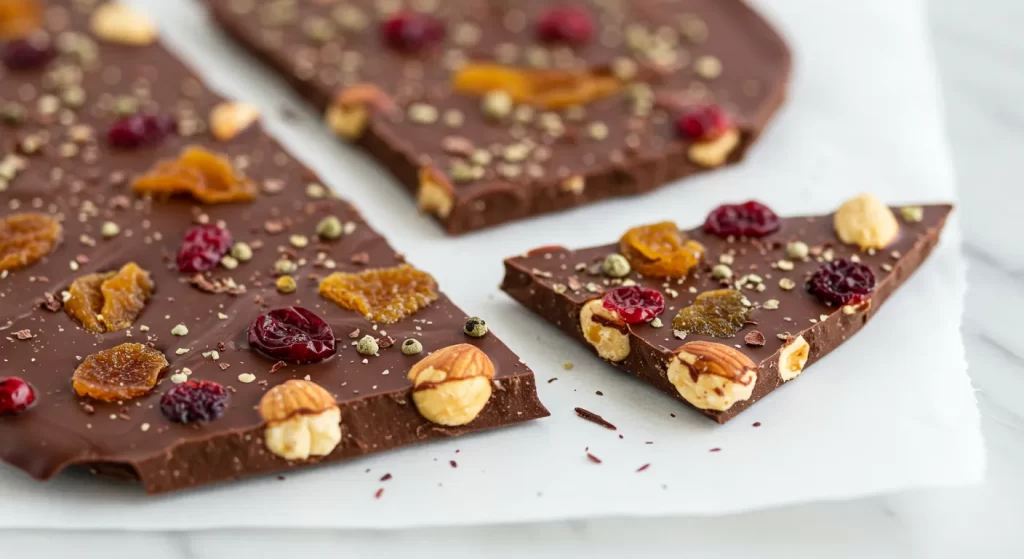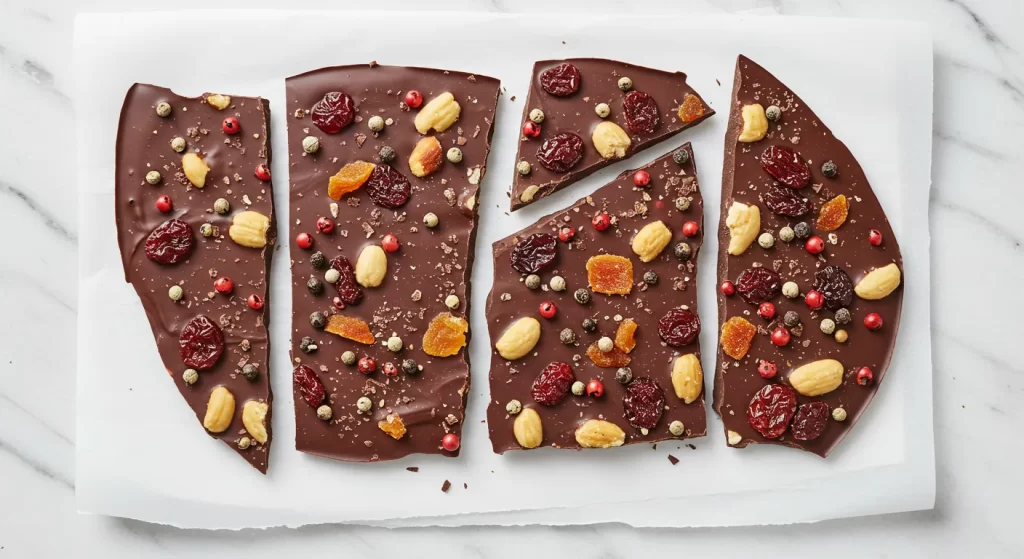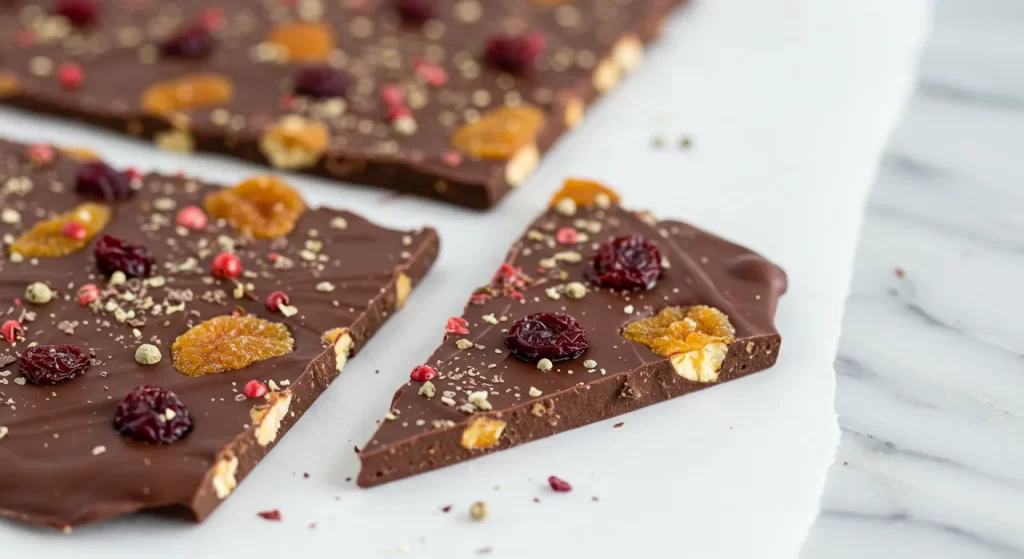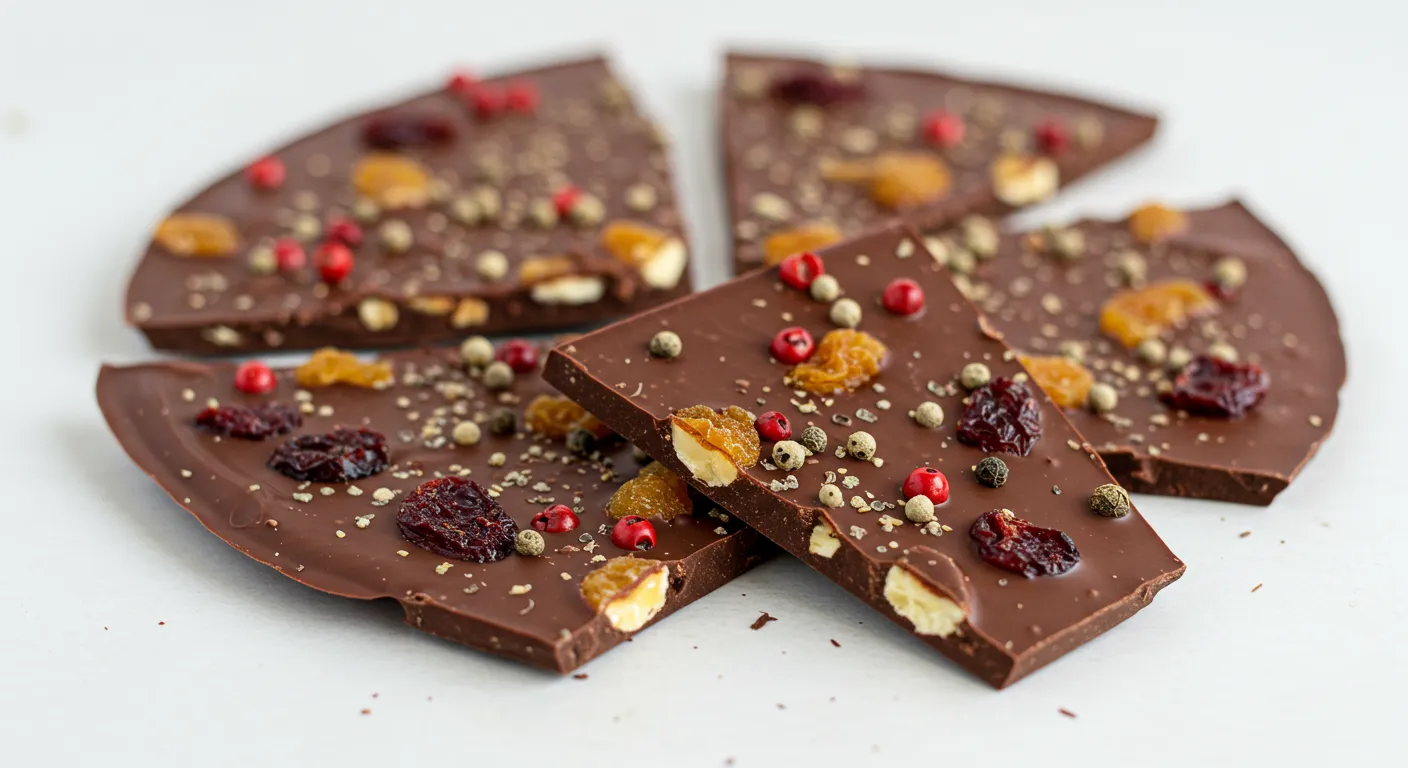Table of Contents
Pepper and Bark
Chocolate bark, a delightful and versatile candy treat, is a canvas for your culinary creativity. It’s a thin layer of chocolate, often topped with various flavorful additions such as spices, nuts, and dried fruits, allowing you to experiment and create your own unique combinations.
Its easy preparation and endless customization options make it a favorite for holidays, parties, and gifts. One twist on classic chocolate bark includes adding pepper. This not only gives a unique spicy flavor that boosts the chocolate’s sweetness but also adds a dose of health benefits. Pepper is known for its antioxidant and anti-inflammatory properties, making it a delicious and nutritious treat.
What is Chocolate Bark?
Chocolate bark is a sheet of chocolate that’s spread into a thin layer, cooled, and broken into irregular pieces. The base chocolate can be dark, milk, semi-sweet, or white. Once the base layer sets, toppings like peppermint, chili, or pepper can be added for a flavorful and aromatic punch. The simplicity of chocolate bark makes it highly customizable, allowing you to experiment with various spices, fruits, and nuts.
The Appeal of Pepper and Bark
The appeal of pepper in chocolate bark lies in the intriguing balance it brings to the table-a perfect harmony of sweet and spicy. Pepper, with its sharp and aromatic qualities, complements the richness of chocolate, creating a flavor profile that’s sure to pique your interest.
This combination creates a unique flavor profile. The subtle heat of black pepper and the intense spiciness of chili pepper transform bare chocolate bark into a special treat. It’s a creative way to experiment with flavors and is ideal for anyone who enjoys a bit of heat in their dessert.
Types of Chocolate to Use for Bark

When creating the perfect chocolate bark, choosing the right type of chocolate is essential. Each variety of chocolate brings a distinct flavor and texture to the bark, which can then be complemented with various pepper types.
Dark Chocolate Bark
Dark chocolate, often chosen for its depth and rich cocoa flavor, pairs wonderfully with pepper. The slight bitterness of dark chocolate enhances the spicy notes of black pepper, making it a classic choice for pepper-based barks. You can experiment with varying cocoa percentages, but most people prefer a range between 60% to 85% cocoa to achieve the perfect balance.
Milk Chocolate Bark
Milk chocolate is sweeter and creamier than dark chocolate, making it an excellent base for those who enjoy a more mellow chocolate flavor. The smoothness of milk chocolate helps tone down the heat from the pepper, creating a balanced combination. Milk chocolate bark also works well with milder pepper varieties like white or pink peppercorns.
Semi-Sweet Chocolate Bark
Semi-sweet chocolate falls between dark and milk chocolate in terms of sweetness, making it an ideal middle-ground for creating pepper and bark combinations. Semi-sweet chocolate has a rich yet slightly sweet profile that enhances the pepper’s spicy flavors without being overpowering.
White Chocolate Bark
White chocolate offers a creamy, buttery sweetness that contrasts beautifully with pepper’s heat. This type of chocolate allows the spicy pepper to shine through, and it’s incredibly delicious when paired with fruity or nutty toppings. It’s a perfect base for experimenting with various pepper types and additional toppings like dried fruits and candied ginger.
The Role of Pepper in Chocolate Bark
Pepper is the star ingredient that brings excitement and adventure to chocolate bark. Whether you’re using black pepper, chili pepper, or more exotic varieties like Kampot pepper, each type of pepper adds its own unique twist to the bark’s flavor, elevating it from a simple treat to a culinary adventure.
Types of Pepper to Use
The type of pepper you use plays a significant role in the final flavor of the chocolate bark. Common options include:
- Black Pepper: Adds subtle heat and depth to the bark without overpowering the chocolate.
- Chili Pepper: For those who enjoy bold flavors, chili peppers (like cayenne or chili flakes) bring a fiery kick to the bark.
- Kampot Pepper: Known for its complex and citrusy flavor, it adds refined heat and works wonderfully with dark chocolate. If Kampot pepper is unavailable, freshly ground black pepper is a suitable substitute.
How Pepper Enhances Flavor
Pepper enhances the flavor of chocolate bark by adding a contrast to the sweetness of the chocolate. The heat from the pepper stimulates the taste buds, heightening the chocolate’s richness and complexity. This combination of sweet and spicy results in a more exciting and nuanced flavor profile that’s sure to please adventurous eaters.
Pairing Pepper with Different Chocolates
When pairing pepper with chocolate, balance is key. Dark chocolate works best with more potent, spicier peppers, while milk chocolate pairs better with milder varieties. White chocolate allows for a more intense pepper flavor, making it suitable for those who enjoy a punchy taste.
Toppings for Your Pepper and Bark Creation

One of the best parts of making chocolate bark is the endless variety of toppings you can add. From crunchy nuts to chewy dried fruits, the possibilities are only limited by your imagination. Pepper and bark can be combined with various flavors to create a unique treat.
Nuts in Chocolate Bark
Nuts add a satisfying crunch and rich flavor that complements the smooth texture of chocolate. Standard nuts like almonds, cashews, pistachios, and hazelnuts are perfect additions to pepper-infused chocolate bark. The savory taste of nuts balances the heat from the pepper, creating a well-rounded flavor profile.
Also Read: Creamy Cocoa Fruit Cup Recipe: Fresh Cacao Delights Await!
Dried Fruits as Toppings
Dried fruits like cranberries, cherries, or raisins introduce a chewy texture and a burst of natural sweetness to the bark. They pair wonderfully with pepper, especially when using more intense spices like chili pepper. The sweetness of dried fruits helps mellow out the heat, creating a perfect harmony of flavors.
Crunchy Additions: Cookies and Candies
Consider adding crushed cookies, candy pieces, or toffee for an extra indulgent treat. These crunchy elements add texture and sweetness, which can help counterbalance the spiciness of the pepper. Peppermint bark, for example, often features crushed candy canes, providing a refreshing and festive touch.
How to Make Your Pepper and Bark
Making your chocolate bark at home is easy and fun. Here’s a simple guide to creating your pepper and chocolate bark masterpiece.
Simple Step-by-Step Instructions
- Melt the chocolate: Break your chosen chocolate into pieces and melt it gently in a double boiler or microwave.
- Prepare your toppings: While the chocolate is melting, prepare your pepper—finely crushed black pepper or chili flakes. You can also chop any nuts or dried fruits you want to use.
- Spread the chocolate: Once melted, pour it onto a baking sheet lined with parchment paper. Use a spatula to spread it into a thin, even layer.
- Add the pepper and toppings: While the chocolate is still soft, sprinkle your pepper and toppings over the surface.
- Cool and break: Let the bark cool in the refrigerator for 1-2 hours. Once set, break it into irregular pieces.
Tips for Melting and Mixing Chocolate
- Use a double boiler: A double boiler helps melt the chocolate gently and evenly. Avoid overheating to maintain the chocolate’s smooth texture.
- Add oil for spreading: If your chocolate is too thick, add a small amount of vegetable oil to make it easier to spread and ensure it hardens smoothly.
- Mixing pepper evenly: For an even distribution of pepper, crush it finely and sprinkle it uniformly across the chocolate before it hardens.
Popular Pepper and Bark Combinations
There are endless possibilities when it comes to creating pepper-flavored chocolate bark. Here are some popular combinations to try:
Spicy Chocolate Bark with Jalapeño
Jalapeño adds a fresh, spicy kick to dark chocolate, creating a bold, exciting flavor contrast. The heat from the pepper pairs well with the deep richness of dark chocolate, making this combination a favorite among those who love spicy treats.
Sweet and Savory Pepper Bark
Try adding a combination of sweet and savory ingredients for a more complex flavor profile. Consider adding sea salt and caramelized onions or bacon bits to the bark along with the pepper. This combo is ideal for those who enjoy balancing salty and sweet flavors.
Pepper and Sea Salt Bark
This classic combo highlights the natural flavors of both chocolate and pepper. The sea salt enhances the chocolate’s richness, while the pepper adds just the right amount of heat. It’s a simple yet sophisticated treat that’s perfect for any occasion.
Storing Your Pepper and Bark

Chocolate bark is easy to store and lasts up to a few weeks if kept in the right conditions.
How to Store Pepper and Bark
Store your chocolate bark in an airtight container at room temperature or refrigerator for a longer shelf life. Please keep it in a cool, dry place to prevent melting.
Health Benefits and Considerations
Chocolate, incredibly dark chocolate, offers various health benefits. Pairing it with pepper only enhances the experience.
The Benefits of Dark Chocolate
Dark chocolate is packed with antioxidants and is known for its heart-healthy properties. Studies suggest that consuming dark chocolate in moderation can improve circulation, lower cholesterol, and boost cognitive function.
Health Benefits of Pepper
Pepper contains piperine, which may help improve digestion, reduce inflammation, and boost metabolism. Pairing pepper with chocolate adds not just flavor but a potential health boost, too.
Why Pepper and Bark Are a Perfect Treat for Any Occasion
Pepper and bark are incredibly versatile, offering endless opportunities for customization. Whether creating a holiday treat, a unique gift, or just indulging in a personal snack, pepper-infused chocolate bark will surely delight your taste buds. Its balance of sweet, spicy, and savory flavors makes it the perfect choice for any occasion.

